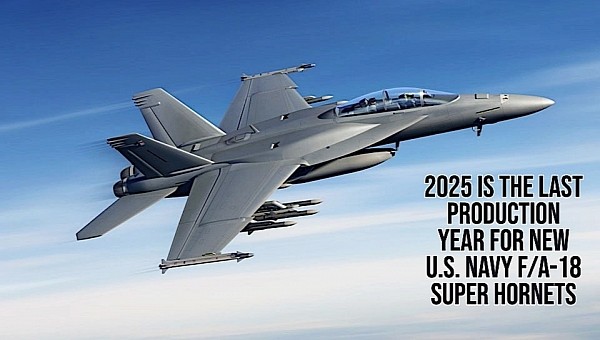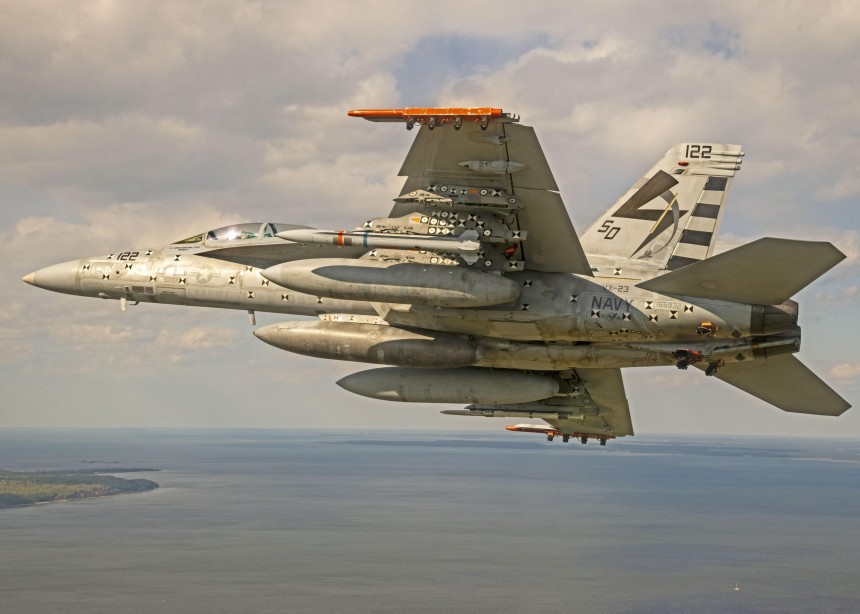It was back in 1983 when an aerospace company that’s no longer around in our time introduced yet another multirole fighter aircraft that could be launched from the deck of an aircraft carrier. McDonnell Douglas was the name of the company, and F/A-18 Hornet that of the airplane.
A lot of time passed since, and in the meanwhile the company merged with giant Boeing. On its end, the plane naturally evolved, and now has two more variants, the F/A-18 Super Hornet and EA-18G Growler It has proven, in all three incarnations, invaluable for U.S. Navy operations across the world.
Like most other planes made back in those days (read 4-gens), the plane is getting old, and Boeing can only do so much to keep it update and cost-relevant. So this week the company announced one of the plane’s variants, the F/A-18 Super Hornet, first flown in 1995, will stop being made for the American military from 2025.
In its current, F/A-18E/F Block III configuration, the fighter jet is equipped with twin engines that can develop 22,000 pounds lbs of thrust each, which is enough to push the thing to a top speed of Mach 1.8 (1,381 mph/2,222 kph). If we're talking weapons, know these planes pack a mighty punch, and they’re generally equipped with a Vulcan 20mm cannon, and an assortment of missiles and bombs (Sidewinders, Sparrows, Harpoons, or Mavericks, among others).
Of the total of some 2,000 Hornets ever made, a little over 600 are Super Hornets, with American forces using the bulk of them. Australia and Kuwait use them too, but in smaller numbers. Boeing said it will wrap up production of the America-bound Super Hornets three years from now, and that’ll probably happen for the other two countries as well. Yet the production of the Super Hornet might continue until 2027, provided the Indian military, presently courted by Boeing, opts to field these planes.
The aerospace company justified the decision to phase out the Navy plane through the need to focus on the new products currently being made for military use. The T-7A Red Hawk, the Air Force’s replacement for the T-38 Talon trainer, will benefit from increased attention as a result of this, and so will the MQ-25 Stingray refueling drone we’ve heard so much about these past few years.
Now, to be fair, the fact that the plane will no longer be made does not mean it will no longer be used, and for quite some time, too. In fact, Boeing admitted it will continue to provide not only maintenance, but also the required upgrades for the existing fleet until at least the middle of the next decade. Not only the Super Hornet, but the Growler too will be subject to such enhancements in coming years.
Boeing’s announcement comes shortly after two F/A-18F Super Hornets from the Flying Eagles squadron were seen in public in American skies, flying over the State Farm Stadium in Glendale, Arizona, before the start of Super Bowl LVII.
Like most other planes made back in those days (read 4-gens), the plane is getting old, and Boeing can only do so much to keep it update and cost-relevant. So this week the company announced one of the plane’s variants, the F/A-18 Super Hornet, first flown in 1995, will stop being made for the American military from 2025.
In its current, F/A-18E/F Block III configuration, the fighter jet is equipped with twin engines that can develop 22,000 pounds lbs of thrust each, which is enough to push the thing to a top speed of Mach 1.8 (1,381 mph/2,222 kph). If we're talking weapons, know these planes pack a mighty punch, and they’re generally equipped with a Vulcan 20mm cannon, and an assortment of missiles and bombs (Sidewinders, Sparrows, Harpoons, or Mavericks, among others).
Of the total of some 2,000 Hornets ever made, a little over 600 are Super Hornets, with American forces using the bulk of them. Australia and Kuwait use them too, but in smaller numbers. Boeing said it will wrap up production of the America-bound Super Hornets three years from now, and that’ll probably happen for the other two countries as well. Yet the production of the Super Hornet might continue until 2027, provided the Indian military, presently courted by Boeing, opts to field these planes.
Now, to be fair, the fact that the plane will no longer be made does not mean it will no longer be used, and for quite some time, too. In fact, Boeing admitted it will continue to provide not only maintenance, but also the required upgrades for the existing fleet until at least the middle of the next decade. Not only the Super Hornet, but the Growler too will be subject to such enhancements in coming years.
Boeing’s announcement comes shortly after two F/A-18F Super Hornets from the Flying Eagles squadron were seen in public in American skies, flying over the State Farm Stadium in Glendale, Arizona, before the start of Super Bowl LVII.











